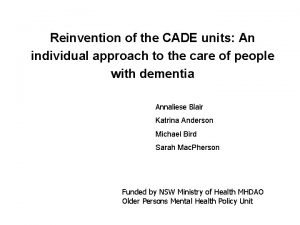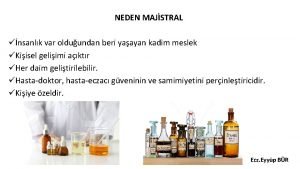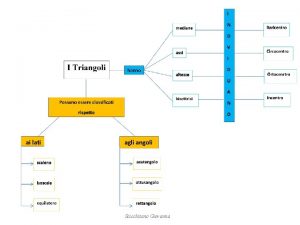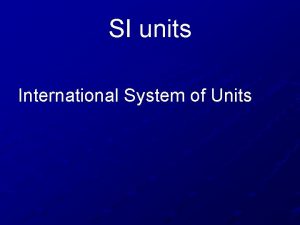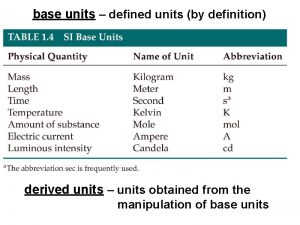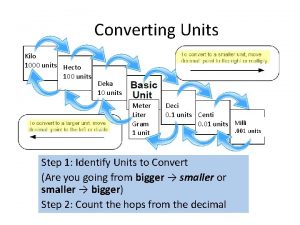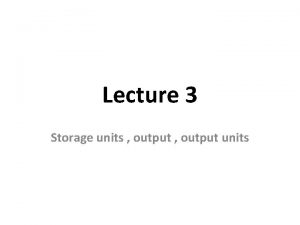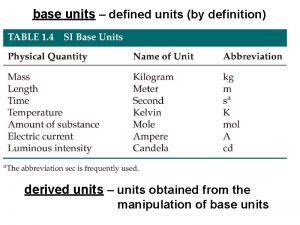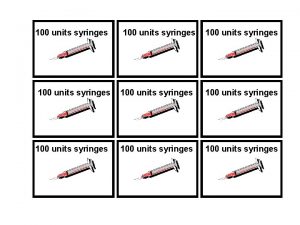Reinvention of the CADE units An individual approach















- Slides: 15

Reinvention of the CADE units: An individual approach to the care of people with dementia Annaliese Blair Katrina Anderson Michael Bird Sarah Mac. Pherson Funded by NSW Ministry of Health MHDAO Older Persons Mental Health Policy Unit

T-BASIS model § § Medical Director - Part-time geriatrician or psychogeriatrician Integrated outreach/inpatient service – ensuring: § § § § § most cases treated in situ, and capacity building takes place most admissions are appropriate and planned follow-up after patients’ discharge Weekly multi-disciplinary case reviews All staff involved in developing and implementing care plans 24 hour nurse and medical coverage Main population at least moderate BPSD Median length of stay 8 -12 weeks Regular staff training.

Broad Evaluation Questions l Are the units adhering to the guidelines and adopting the model? l Are the units clinically effective?

Number of patients with primary diagnosis (N=118)


Mean number of behaviour incidents in first two weeks after admission

How behaviours were responded to (%) Figure 1. Psychosocial Figure 2. PRN medication

‘What would you have done if there wasn’t a T-BASIS unit? ’

Case example l Admitted to hospital after a fall at home – she was not given any pain relief l Multiple physical co-morbidities l Continuously wandered into other patients’ rooms and got into bed with them and frequently had to be removed by security staff l She was given Valium and Haloperidol, restrained using manacles, and specialled for 7 consecutive days.

Case example (cont. ) l No incidents of aggression or inappropriate behaviour in the first 48 hours and few thereafter l The design of the T-BASIS units means that doors can be locked but the main ‘treatment’ was redirection by staff l Haloperidol, Temazepam and Valium was ceased l She was given substantial pain relief l Remained on Risperidone l Discharged to residential care after 12 weeks.

Average number of behavioural incidents per patient at admission and discharge by unit

Reason for discharge (%)

Where did they go?

Feedback l Families – – – l I’ve got my mum back. I’m so grateful to them for getting mum better; it was a God-send … the staff took mum's behaviours in their stride and worked with her in a really caring and sensitive way The social worker was astronomical: she was so attentive to him [the patient] and she conversed with him as well as with me. Residential Facilities – – RACF staff were asked to rate their satisfaction with the service on a scale of 1 = extremely dissatisfied to 5= extremely satisfied. M Score = 3. 86 (SD = 0. 90).

Acknowledgements l The Nursing Unit Managers and staff who welcomed us so warmly and who also welcomed the fact that there was going to be an evaluation so they could assess their progress. l The families of patients in the T-BASIS units who gave us permission to look at the medical files, and some of whom allowed us to interview them about quality of care. l Richard Fleming and John Bowles, whose commitment to improving the care of people with dementia and challenging behaviour in health services led to the development of the original CADE units. l The NSW Ministry of Health which funded the evaluation and is committed to further improvement of the model and the care of older people with dementia
 What is the falling action of raymond's run
What is the falling action of raymond's run John cade unit
John cade unit Johnny cade characteristics
Johnny cade characteristics Cold krem majistral
Cold krem majistral Cade kruse
Cade kruse Ortocentro esterno
Ortocentro esterno Ponyboy curtis physical description
Ponyboy curtis physical description Cade
Cade Cherry valance physical description
Cherry valance physical description Aplicatii ale fenomenului de reflexie totala
Aplicatii ale fenomenului de reflexie totala Uma cadeia alimentar
Uma cadeia alimentar Vilicia cade
Vilicia cade Kristen hannon
Kristen hannon Botox dosage forehead
Botox dosage forehead Income statement for absorption costing
Income statement for absorption costing Fine-grained screening
Fine-grained screening

